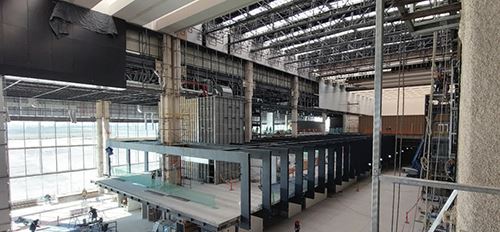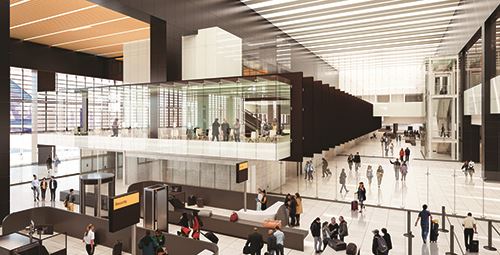When the CrossBorder Xpress terminal opened about six years ago, officials knew its pedestrian bridge directly linking Tijuana’s General Abelardo L. Rodriguez International Airport (TIJ) and the U.S. would be popular. What they didn’t expect was a 100% increase in passenger traffic.
When the CrossBorder Xpress terminal opened about six years ago, officials knew its pedestrian bridge directly linking Tijuana’s General Abelardo L. Rodriguez International Airport (TIJ) and the U.S. would be popular. What they didn’t expect, however, was a whopping 100% increase in passenger traffic at the airport.
 Naturally, the increase in business was well received. But it also placed an immense amount of pressure on airport infrastructure—enough to prompt construction of a $100 million (USD) Transit Processing Building immediately adjacent to TIJ’s main terminal just for passengers using the transborder bridge. When this issue went to press in February, the newly constructed facility was on track to begin serving domestic passengers in March, and was slated to be fully operational for international passengers by the end of this year.
Naturally, the increase in business was well received. But it also placed an immense amount of pressure on airport infrastructure—enough to prompt construction of a $100 million (USD) Transit Processing Building immediately adjacent to TIJ’s main terminal just for passengers using the transborder bridge. When this issue went to press in February, the newly constructed facility was on track to begin serving domestic passengers in March, and was slated to be fully operational for international passengers by the end of this year.
“This increase in traffic was a surprise for all of us,” says José Ángel Martínez Sánchez, chief operations officer for Grupo Aeroportuario del Pacífico, the entity that operates 12 airports in Mexico (including TIJ) and the CrossBorder Xpress terminal. “We knew the bridge was an opportunity for the region. But the growth and traffic were much more than expected. We needed more space to handle the passengers that were using the bridge, offer better services and improve the infrastructure. This building will now be able to manage all the passengers crossing the bridge, heading either into Mexico or out of Mexico.”
|
Location: General Abelardo L. Rodriguez Int’l—Tijuana Project: Transit Processing Building Size: 4 stories; 45,000 sq. meters Cost: $100 million (USD) Funding: Passenger revenue & airport investments, with approval from Mexican government Timeline: Open for domestic travelers in March 2022; slated to begin serving int’l passengers by year-end Engineer & Architectural Designer: WSP Conceptual Design: Lam arquitectos/Estudio Lamela Architectural Developer: Serrano & Monjaraz Baggage Handling System: Vanderlande Checked Baggage Screening Equipment: Surescan Automatic Screening Lanes for Carry-On Items: Nuctech Passenger Screening Machines: Nuctech Foundation Piles: Sandstorm GAM Structure: Grupo Recal Masonry, Finishing, Hydro-sanitary Installations: GIA Aluminum Works & Panels: Constructa
Electrical Installations: Impulsora Eléctrica HVAC: Johnson & Johnson Mexico Vertical Circulation Equipment: Otis de México Moving Walkways: Thyssen México Porcelain Flooring Tiles: Atlas Concorde Additional Terminal Seating: Arconas Low-e Windows: Clear Solutions |
The new Transit Processing Building, designed by Lam Architects/Estudio Lamela Mexico, allows international passengers arriving at TIJ to proceed directly to U.S. Customs and Border Protection without first passing through Customs and Immigration in Mexico. Passengers coming from the U.S. via the border bridge can head directly to their flights through a sterile transit process. The impact on flow within the airport is expected to be dramatic, as an estimated 35% of all TIJ passengers use the pedestrian bridge.
At 45,000 square meters, the new facility more than doubles TIJ’s overall footprint. (The main terminal itself is 40,000 square meters.) Because the two structures are connected, domestic passengers can immediately go to their gates after processing, and international passengers will wait for departing flights in a sterile holding area equipped with seating and tables. The Transit Processing Building also smooths the arrivals process. After deplaning, passengers en route to the U.S. can simply pass through the new facility and cross the pedestrian bridge.
“This is a unique building,” Martínez Sánchez says. “Because the bridge spans the border between two countries, there is not a structure like this in the world.” (More details about the CrossBorder Xpress terminal and bridge are available in the March/April 2016 issue of Airport Improvement magazine.)
Funding for the new Transit Processing Building came from passenger revenue and airport investments, with approval from the Mexican government.
Handling Traffic Surge
The biggest challenge for the project team was achieving efficient passenger flow through the four-story building. “We knew we needed to manage all the different movements while having isolated spaces specifically for each flow,” says Martínez Sánchez. “It needed to be a facility that carefully limited flow depending on where passengers are going or where they are coming from.”
Although it is physically connected to the airport’s main terminal, the Transit Processing Building has its own:
- baggage handling system
- screening equipment for checked baggage (including tomography explosives detection)
- screening lanes for carry-on items with X-ray machines and automated tray return
- passenger screening equipment
- Customs and Immigrations checkpoints
Having two sets of such equipment and facilities allows TIJ to separate passengers traveling to destinations in Mexico from those traveling internationally.
Passengers coming from the U.S. en route to domestic destinations within Mexico cross the bridge, complete the Customs and Immigration process, check their bags, pass through the security checkpoint and then enter the terminal building to wait for their flight.
Passengers coming from the U.S. en route to international destinations such as Panama City cross the bridge and immediately check their bags. “They will not have to do Immigration or Customs, because they will be in transit in the building,” Martínez Sánchez explains. “They go directly to the check-in area for international flights and are in an isolated holding area while waiting to board their flight.”
Passengers arriving at TIJ and proceeding to the U.S. across the bridge report directly to U.S. Customs and Border Protection—the same international arrivals process used at U.S. airports. Essentially, these passengers bypass official entry into Mexico.
Carlos Gómez Chinchón, general director of Lam arquitectos/Estudio Lamela Mexico, notes that it was imperative for the new building to interface aesthetically and physically with the older main terminal.
 “The existing building had undergone many quick renovations, so the complex lacked unity,” says Chinchón. “Our initial idea was to unify the new with the old to create a guideline for the future. Although all airports implicitly bring the idea of a gateway to a city, in this case, this concept was extended to be the gateway to a country, as it’s situated next to the border with the U.S.”
“The existing building had undergone many quick renovations, so the complex lacked unity,” says Chinchón. “Our initial idea was to unify the new with the old to create a guideline for the future. Although all airports implicitly bring the idea of a gateway to a city, in this case, this concept was extended to be the gateway to a country, as it’s situated next to the border with the U.S.”
Adding the new Transit Processing Building is not the only change TIJ has made to accommodate surges in passenger traffic. The airport recently installed 580 additional seats in its main terminal—360 in the domestic hold area and 220 in the international hold area. Pablo Reich, executive vice president for Arconas, notes that project designers selected the company’s Flyaway Tandem series, configured in rows of four seats each. The new seats have high backrests, and fully half are equipped with power outlets for phones and other mobile devices.
Clear Improvements
The new processing building includes a large amount of glass, including skylights that add natural light and partitions to help direct passenger flow. Due to the local climate, the design team specified double glass with an air chamber to reduce thermal losses, increase acoustic insulation and achieve a comfortable environment for building occupants. Chinchón explains that even though Tijuana typically has mild temperatures, the thermal sensation is often extreme and dry.
Glass partitions provide transparency regarding the movement of people, aircraft and operating machinery. “We believe that there’s a certain beauty in being part of that process, and we wanted to propose a very open building where everyone could see and be seen,” says Chinchón. “On the other hand, the necessary process to reach the plane is complex and sometimes stressful from fear of missing the flight. Simplifying the routes and controls also helps to reduce this situation of concern of the users. Although some understand airports as processing machines, we always like to consider the people who use them, and [therefore] enhance all the intensity and beauty that is generated through generous and intentional spaces that generate amplitude and relief.”
The Transit Processing Building also includes offices for personnel who support the CrossBorder Xpress terminal.
International Team
Alejandro Vallarino Marusich, chief infrastructure officer of Grupo Aeroportuario del Pacífico, notes that the project was unique because it brought together “an international group of high-level specialists” throughout its three different phases.
 While the architect for the conceptual stage was Carlos Lamela of Estudio Lamela in Spain, the executive development involved WPS contracting with Mexico City Architect Juan Pablo Serrano (Serrano + Monjaraz). They executed the architectural component and consolidated the digital design through building information modeling into a LOD 350 model, explains Vallarino.
While the architect for the conceptual stage was Carlos Lamela of Estudio Lamela in Spain, the executive development involved WPS contracting with Mexico City Architect Juan Pablo Serrano (Serrano + Monjaraz). They executed the architectural component and consolidated the digital design through building information modeling into a LOD 350 model, explains Vallarino.
The construction phase was carried out by Mexican companies Sandstorm GAM (foundation piles), Grupo Recal (structure), GIA (masonry, finishing and hydro-sanitary installations), Constructa (aluminum works and panels), Impulsora Eléctrica de los Altos (electrical installations), Johnson & Johnson Mexico (HVAC), Otis de México (passenger lifting equipment) and Thyssen México (moving walkways), among others.
“All these world-class professionals managed to design and build this one-of-a-kind building in the world,” says Vallarino.
More Growth Expected
When the transborder pedestrian bridge opened in late 2015, TIJ essentially became a binational port of entry. Back then, TIJ served about 5 million annual passengers. By 2021, end-of-year figures showed the airport served nearly 10 million passengers—and officials expect that number to continue climbing. “The 100% increase in traffic was mainly because of the bridge, because we offer a very seamless process,” says Martínez Sánchez. “There are a lot of people crossing the bridge and going to San Diego and vice versa.”
Moreover, he notes that flying into TIJ and crossing the bridge tends to be less expensive than flying into San Diego International (SAN) or Los Angeles International (LAX). “After London Gatwick, SAN is ranked second in the world for airport congestion and one runway,” adds Martínez Sánchez. “We also have only one runway, but we have space available and don’t have issues with congestion.”

He and other officials feel it is important for TIJ to have the right resources in place to grow, because the airport is an important economic engine for northern and central Mexico. As such, an analysis is currently underway to determine the feasibility of adding a second runway. “We don’t see the airport as an isolated infrastructure,” Martínez Sánchez explains. “The airport has to be a key player in the development of the region.”
Airport officials note that TIJ presents significant opportunities for expanded international air service, particularly from Asia and Latin America. A key factor to its draw is a catchment area that includes almost 23 million people in Southern California who can easily access TIJ using the pedestrian bridge. Currently, nearly 67,000 passengers fly between Tijuana/Southern California and Asia each week. In addition, growth in Tijuana’s manufacturing sector is helping the city attract 80,000 new residents each year.
Martínez Sánchez notes that beyond offering airlines a growing base of potential passengers, TIJ’s operating fees are 70% less than SAN or LAX. That makes TIJ a low-cost option for carriers interested in serving both Tijuana and San Diego, he adds.
For now, Martínez Sánchez considers the new Transit Processing Building a great improvement for the airport. “Before, we had to process all these passengers going back and forth on the bridge in a very small area with a lot of congestion,” he says. “It was a very bad quality of service. Now, these processes are in a new building with new technology and more space.”


 facts&figures
facts&figures

